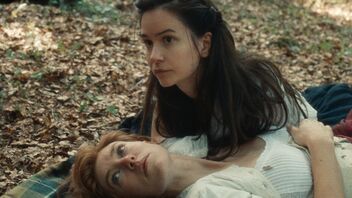Subtitles, self-descriptions, ASL, land acknowledgements and more: Ella Kemp reports on the Sundance Film Festival’s 2021 accessibility offerings.
It’s been a big year for CODA, Siân Heder’s heartwarming coming-of-ager that tells the story of Ruby, the eponymous hearing daughter of Deaf adults, who longs to be a singer. The film was acquired by Apple for a record-breaking $25 million (topping last year’s Hulu acquisition of Palm Springs for $22 million), and has now won three awards at the festival: the US Grand Jury Prize, US Dramatic Audience Award and a Special Jury Ensemble Cast award, too. Congratulations to the team!
But the film is also indicative of a wider movement growing at the festival. The 2021 edition of Sundance, taking place mostly online, is one of the first major film festivals to offer subtitles for every single title playing online. From land acknowledgements to inclusive juries, the Sundance team’s dogged ambition to provide a festival that’s as representative and accessible as possible has not gone unnoticed.
Writer and Letterboxd member Julian Singleton is a CODA who was raised in a film-loving household, and has been reaping the benefits of recent efforts to invite Deaf and Hard-of-Hearing audiences to enjoy major festival premieres just as much as everyone else. “It wasn’t until 2020 [that my parents] were able to see a movie at a film festival for the first time, with Nomadland at the New York Film Festival,” Julian tells me. “Since then, it’s been amazing to see some of the world’s top film festivals adopt accessibility practices—and Sundance by far has been ahead of the curve when it comes to making accessibility a standard and a mission.”
Julian managed to catch Flee, Eight for Silver, In the Earth and Prisoners of the Ghostland at the festival. Four films which couldn’t be more different, and which toy with sound and dialogue in exciting and boundary-pushing ways that deserve to be appreciated by everyone.
“There’s a big difference between subtitling and captioning a film—for example, with Flee, while non-English dialogue was subtitled, the available captions still provided contextual sounds (music, sound effects) that are deliberate choices by the filmmakers but would go unheeded by a Deaf/HOH audience,” Julian explains.
And Sundance’s mission is wide-reaching too, as Julian adds that the festival also offers descriptive audio options, dyslexia-friendly fonts, contrast options, and the ability to change font sizes as well. In ‘Who Tells The Story?’, a of filmmakers of color held during the festival, the participants (including Judas and the Black Messiah director Shaka King) self-described their hair, clothes, color and race by way of introduction. “This is all stuff I’ve never seen past film festivals even consider implementing,” Julian says. “It means so, so much for making the film festival experience as equitable and wide-reaching as possible.”
He’s yet to see CODA, but it says something about filmgoers’ priorities in 2021 that such a film, starring several tremendous Deaf actors alongside Emilia Jones as Ruby—Marlee Matlin and Troy Kotsur as her parents, with firecracker chemistry; Daniel Durant as her empathetic brother—has spoken to the hearts of so many.
It’s built into the integrity of the cast: CODA is a remake of 2014 French film La Famille Belier, in which the Deaf family was played by hearing actors who learned sign language for their roles. The quirks of the family play so much better in CODA with Matlin, Kotsur and Durant (pictured) performing in their native ASL.
Julian says he hopes subtitling across festivals will become “a requirement, not an afterthought,” while also noting just how valuable online screenings can be—and will continue to be—even when in-person sessions return around the world. The demand, and the gratitude, is there. Your move, Cannes.

